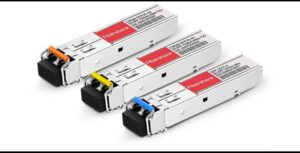
What is an SFP?
- An SFP (Small Form-factor Pluggable) is a compact, hot-swappable transceiver used in networking hardware for optical and Ethernet communications.
- SFPs are widely used to enable high-speed data transmission in telecommunications and data center environments.
Key Features
- Hot-swappable
- Can be installed or replaced without powering down the device.
- Versatile Connectivity
- Supports both fiber optic and copper cables, allowing integration into diverse network environments.
- Speed Compatibility
- Common data rates: 1 Gbps (SFP), 10 Gbps (SFP+), 25 Gbps, 40 Gbps, and up to 100 Gbps.
- Range Flexibility
- Different modules are available for varying transmission distances, from a few meters (copper) to tens of kilometers (fiber).
- Compatibility with Standards
- Compliant with IEEE standards and Multi-Source Agreement (MSA).
Types of SFP Modules
- Fiber-based SFPs:
- Single-mode (SMF): Designed for long-distance data transmission (up to 80 km or more).
- Multi-mode (MMF): Suitable for short-range applications (up to 500 m).
- Copper-based SFPs:
- Use RJ-45 connectors and Cat5e/6/6a cables for Ethernet connectivity, supporting distances of up to 100 meters.
- Specialty SFPs:
- BiDi SFPs: Transmit and receive on a single fiber strand using different wavelengths.
- CWDM/DWDM SFPs: Support wavelength division multiplexing for high-density networking.
Applications
- Telecommunications: Backbone connections in ISPs and telecom operators.
- Data Centers: High-speed links between switches, servers, and storage devices.
- Enterprise Networks: Interconnect switches and routers.
- Fiber to the Home (FTTH): Optical links between central offices and end-users.
Key Parameters to Consider When Choosing an SFP
- Transmission Speed: Match the module to the port speed (e.g., 1G, 10G, etc.).
- Cable Type: Decide between fiber optic or copper based on your setup.
- Transmission Distance: Ensure the module supports the required range.
- Wavelength: Must align with the wavelength supported by your network equipment.
- Compatibility: Ensure compatibility with the switch or router.
- Power Budget: Verify the module can provide sufficient power for signal transmission.
Maintenance Tips
- Use dust caps when the SFP is not in use to avoid contamination.
- Avoid forceful insertion or removal; always use the latch mechanism.
- Regularly clean optical connectors to maintain signal quality.
- Check firmware updates for compatibility improvements on managed devices.
𝐒𝐑 , 𝐄𝐑 , 𝐙𝐑 , 𝐋𝐑 ,… 𝐎𝐩𝐭𝐢𝐜𝐚𝐥 𝐓𝐫𝐚𝐧𝐬𝐜𝐢𝐯𝐞𝐫 ,, 𝐋𝐞𝐭𝐬 𝐤𝐧𝐨𝐰 𝐭𝐡𝐞𝐦
– first of all you should know that optical transsciver is a very important device in wdm system
– we usually use optical modules to transport optical signals and convert electrical to optical and vice versa
– we call it SFP : small form factor pluggable
– there are alot of types and parameters you should look to choose the suitable one for the network design
– sfp parameters like below :
Receive sensitivity
Tx power
Temperature
Wavelength
Extinction ratio
Bias current
Data rate
Insertion and return loss
– We will explain them in next post
– Now lets have a look on the types of optical modules classified based on distance range
𝐕𝐒𝐑 : very ahort range , support up to 100 meter
𝐒𝐑 : short range , support around 300 meter on multimode fiber
𝐌𝐑 : medium range , up to 2 km
𝐋𝐑 , long range , works with single mode on 1310 nm and support up to 10 km
𝐄𝐑 : extended range , single mode too but with 1550 nm and support up to 40 km
𝐙𝐑 : ultra extended range support up to 80 km on single mode fiber 1550
SR4 , LR4 , ER4 use 4 lanes 25 G fiber